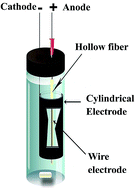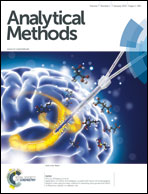Electromembrane extraction using a cylindrical electrode: a new view for the augmentation of extraction efficiency
Abstract
In the present work, for the first time, a cylindrical electrode that surrounded a hollow fiber membrane was introduced in electromembrane extraction (EME). The setup introduced produces an efficient, inexpensive, stable, and reproducible method for increasing the extraction efficiency of ionizable compounds from different matrices. The method was applied for the extraction of diclofenac and mefenamic acid as model analytes from biological fluids. Effective parameters on EME of the analytes, such as extraction time, applied voltage, and composition of acceptor/donor phases, were investigated and optimized using the experimental design. Under optimized conditions, relative recoveries in the range of 94–105 and preconcentration factors in the range of 50–355 were obtained in various biological matrices. The linear dynamic range of 2.5–500 μg L−1 (with coefficient of determination better than 0.9986) and limit of detection of 0.25 μg L−1 were obtained for both of the analytes in plasma and urine samples. The figures of merit of EME with a cylindrical electrode were compared with the results obtained from conventional EME.


 Please wait while we load your content...
Please wait while we load your content...